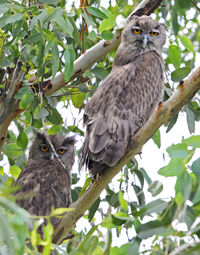| Dusky Eagle-owl | |
|---|---|

| |
| Scientific classification | |
| Kingdom Information | |
| Domain | Eukaryota |
| Kingdom | Animalia |
| Subkingdom | Bilateria |
| Branch | Deuterostomia |
| Phylum Information | |
| Phylum | Chordata |
| Sub-phylum | Vertebrata |
| Infraphylum | Gnathostomata |
| Class Information | |
| Superclass | Tetrapoda |
| Class | Aves |
| Sub-class | Neornithes |
| Infra-class | Neoaves |
| Order Information | |
| Order | Strigiformes |
| Family Information | |
| Family | Strigidae |
| Sub-family | Striginae |
| Genus Information | |
| Genus | Bubo |
| Species Information | |
| Species | B. coromandus |
| Population statistics | |
| Conservation status | Least concern[1] |
The dusky eagle owl (Bubo coromandus) is a bird of prey in the family Strigidae, and is found in southern and Southeast Asia.
Contents
Description[edit]
The dusky eagle owl is a relatively large owl, reaching a body length of 18 to 20 inches. The feathers are greyish to sooty, dusky brown. The eyes are yellow. The ear tufts are very conspicuous, stand upright and are relatively close together. The facial disk has a narrow dark edge.
Range[edit]
Dusky eagle owls are found on the Indian subcontinent; from Pakistan south of the Himalayas as well as the Indian Sind, Punjab and Uttar Pradesh east to Nepal and Bangladesh, and have been recorded as far east as southeastern China. In Southeast Asia they also occur in western Burma, with three owls (possibly stragglers) collected on the Malay Peninsula.
Dusky eagle owls live in areas with dense forests and wetlands, both of which have a close proximity to water, and up to an elevation of 820 feet. It is also found in plantations, groves, old tamarind stands, or other human-altered landscapes in which there is an abundance of leafy trees offering concealment.
Habits[edit]
The dusky eagle owl usually becomes active at dusk, and unlike many owls it will frequently become active during the day, especially on cloudy days or in light rain. Its diet includes small mammals, birds, reptiles, frogs, fish and large insects, which have been identified by means of pellets regurgitated and dropped at their nesting sites.
The reproduction time falls in the period from November to April, with the peak of the breeding season in northern India from December to January. Abandoned nests of other large bird species are taken over, and the female will lay two eggs placed some distance from each other, with the result of a developmental difference between the nestlings.